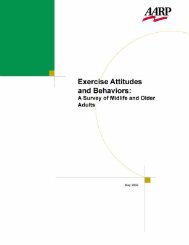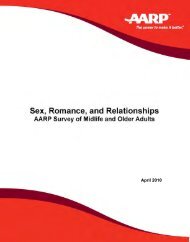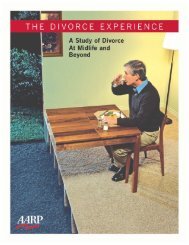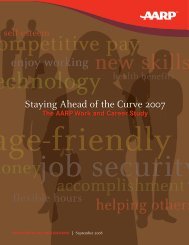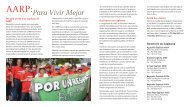The New Aging Enterprise - aarp
The New Aging Enterprise - aarp
The New Aging Enterprise - aarp
Create successful ePaper yourself
Turn your PDF publications into a flip-book with our unique Google optimized e-Paper software.
Elderhostel's growth has been extraordinary. 96 <strong>The</strong> program grew from 220 participants<br />
in 1975 to 20,000 five years later. By the year 2000, Elderhostel was enrolling nearly 200,000<br />
participants each year and had become the largest education-travel program in the world.<br />
Despite growth, Elderhostel has retained most elements of the original learning plan: a week or<br />
two of organized but informal learning activities sponsored by a host institution (college or<br />
university, and, increasingly, environmental center, national park, museum, and so on). <strong>The</strong><br />
national and international Elderhostel network is administered by a nonprofit organization<br />
headquartered in Boston. Maintaining a stable structure and commitment to informal, agencyoriented<br />
learning has conferred huge advantages on Elderhostel. On the one hand, Elderhostel<br />
operates as a franchise, and the term “Elderhostel” is a legally registered trademark.<br />
Elderhostel remains a not-for-profit organization, though it operates in many ways as a<br />
business enterprise. Although managing a vast travel network, liberal education remains the core<br />
of Elderhostel's mission. Elderhostel is best understood as a “nonprofit business” and the<br />
organization offers scholarships to those learners who would otherwise be unable to attend its<br />
offerings. While no two programs are alike, all Elderhostel programs emphasize learning in a<br />
collegial environment, featuring lectures by experts combined with field trips for a more handson<br />
learning experience.<br />
Elderhostel began as an organization for people age 60 and older, but has since reduced<br />
its age requirement to 55 and also offers intergenerational programs. In early years,<br />
Elderhostelers slept in college dorms and ate in cafeterias. But, accommodations have changed,<br />
and more amenities were added so that today many Elderhostelers stay in hotels or conference<br />
centers. Elderhostel has also changed its core program to respond to aging Boomers who are<br />
now making up a growing portion of its participants. In 2002, Elderhostel introduced a new subbrand,<br />
“Road Scholar,” which is available without age-restrictions, although featuring high-end<br />
parts of the Elderhostel program and focusing on a population beyond middle age.<br />
<strong>The</strong> University of the Third Age. <strong>The</strong> idea for a “University of the Third Age” (U3A)<br />
was originally proposed in 1973 by Pierre Vellas, 97 and the first experiment along these lines was<br />
created at the University of Toulouse in France. Vellas had in mind a new kind of educational<br />
enterprise for older adults: an initiative that would enhance the quality of life and strengthen<br />
intergenerational ties, while at the same time promoting research in the field of gerontology.<br />
Since its beginning, the U3A movement has spread to all continents, 98 becoming a global<br />
phenomenon, and, comprising, literally, thousands of locally developed U3A programs of<br />
remarkable variety.<br />
Universities of the Third Age have followed different models but two ideal types predominate:<br />
the French model, based on close association with a traditional university, and the British model,<br />
which operates more in the spirit of mutual-aid and self-help. 99 <strong>The</strong> French model was<br />
32



